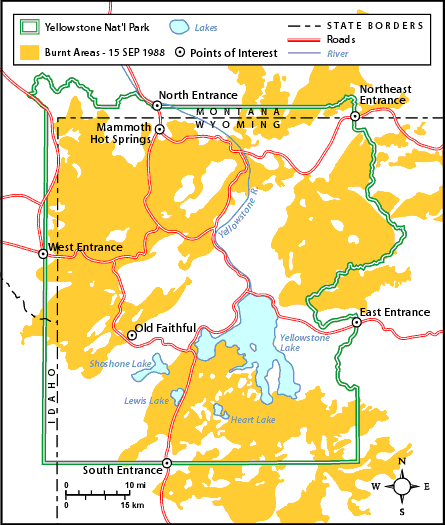 |
| Overall burn map, Yellowstone National Park Summer 1988 |
The mainstream media bore down on and blamed President Reagan, Secretary of Interior Donald Hodel, the National Park Service Director William Penn Mott Jr., and Yellowstone NPS Superintendent Robert Barbee for failing to reverse the threats of dry lightening, hot winds and drought and permitting fires to run out of control, as fires approached critical areas.
The peak burning day was September 9th (see Fire Growth Maps for the 1988 GreaterYellowstone Area Fires, page 7) only two days before nature took the forests back and initiated the processes of growth and renewal.On September 7, high winds brought the North Fork Fire blaze to the Old Faithful complex, the first time fire had threatened the area in the 116-year history of the park. An aerial suppression assault attempted to slow the fire’s progress, but those efforts failed. Early in the morning, the National Park Service evacuated the complex. Between 500 and 600 people left by the 10 a.m. deadline, although visitors traveling by car still were allowed to visit the geyser as late as mid-afternoon, some arriving just minutes before the firestorm struck. The fire eventually encircled the Old Faithful area, and firefighters successfully battled to save the Old Faithful Inn as well as the electrical substation nearby. The fire burned so hot that it melted the rubber off the wheels of cars and a truck, shattered vehicle windshields, and scorched their paint. As many as nineteen buildings in the area burned to the ground, and the old dormitory building suffered damage.
Fire viewed from Old Faithful Inn
Approaching the Old Faithful Snow Lodge
September 7, 1988
By September 11, 1988, the first snows of autumn had dampened the fires as the nation's largest fire-fighting effort could not. The imminent danger to life and property was over, and firefighters were gradually sent home, although the last of the smoldering flames were not extinguished until November. Staff in Yellowstone National Park went to work surveying the impacts of the fires on wildlife, plants, historic structures, trails, and more and answering the demands for information, explanation, and a new fire management policy.
 |
| The year after, wildflowers thrived. |
A total of 248 fires started in greater Yellowstone in 1988; 50 of those were in Yellowstone National Park. Despite widespread misconceptions that all fires were initially allowed to burn, only 31 of the total were; 28 of these began inside the park. In the end, 7 major fires were responsible for more than 95% of the burned acreage. Five of those fires were ignited outside the park, and 3 of them were human-caused fires that firefighters attempted to control from the beginning. More than 25,000 firefighters, as many as 9000 at one time, attacked Yellowstone fires in 1988, at a total cost of about $120 million. Thankfully, the fires killed no park visitors and no nearby residents. Outside the park, two firefighters were killed, one by a falling tree and one while piloting a plane transporting other personnel.
Ecosystemwide, about 1.2 million acres was scorched; 793,000 (about 36%) of the park's 2,221,800 acres were burned. Sixty-seven structures were destroyed, including 18 cabins used by employees and guests and one backcountry patrol cabin in Yellowstone.
The aftermath was not dire, not at all. The 1988 fires created a mosaic of burns, partial burns, and unburned areas that provided new habitats for plants and animals and new realms for research. What scientists have learned?
- Fertile soil with good-water holding capacity and dense, diverse vegetation before the fire recovered quickly.
- Grasslands returned to pre-fire appearance within a few years.
- Many of the burned forests were mature lodgepole; this species is recolonizing most of the burned areas.
- The first seedlings of Engelmann spruce, subalpine fir, Douglas-fir, and whitebark pine have emerged.

Forest recovery on far bank of Madison River. - Aspen reproduction has increased because fire stimulated the growth of suckers from the aspen's underground root system and left behind bare mineral soil that provides good conditions for aspen seedlings.
- Some of the grasses that elk eat were more nutritious after the fire.
- Bears graze more frequently at burned than unburned sites.
- The fires have had no observable impact on the number of grizzly bears in greater Yellowstone.
- Cavity-nesting birds, such as bluebirds, had more dead trees for their nests; birds dependent on mature forests, such as boreal owls, lost habitat.
- No fire-related effects have been observed in the fish populations or the angling experience in the six rivers that have been monitored regularly since 1988.
- Vegetation growth has slowed erosion in watersheds that had erosion and mudslides after the fires, such as the Gibbon River.
Out of destruction comes renewal. Amen.

No comments:
Post a Comment